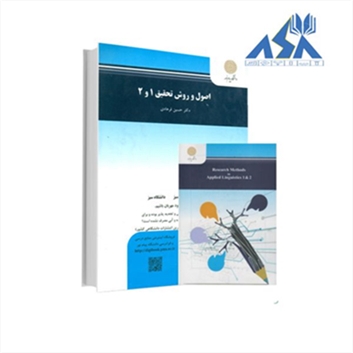TABLE OF CONTENTS (فهرست مطالب)
Acknowledgements
Preface
Section One: The Concept of Research
Chapter 1. Background
Objectives of the Chapter
1.1 Introduction
1.2 Sources of obtaining Information
1.2.1 Sensory Experience
1.2.2 Expert Opinion
1.2.3 Logic
1.3 The Scientific Method
Self-Assessment Activities
Chapter 2. Principles of Research
Objectives of the Chapter
2.1 Introduction
2.2 Characteristics of Research
2.2.1 Research Is Systematic
2.2.2 Research Is Logical
2.2.3 Research Is Reductive
2.2.4 Research Is
2.2.5 Research Is Generative
2.3 Goals of Research
2.3.1 Description
2.3.2 Prediction
2.3.3 Improvement
2.3.4 Explanation
2.4 Kinds and Methods of Research
2.4.1 Exploratory and Confirmatory Research
2.4.2 Pure and Applied Research
2.5 Steps in Conducting Research
2.5.1 Forming a Research Question
2.5.2 Selecting an Appropriate Research Method
2.5.3. Testing the Research Hypotheses
2.5.4 Preparing the Research Report
Self-Assessment Activities
Section Two: Formulating Research Questions
Chapter 3. Areas of Research in Language Education
Objectives of the Chapter
3.1 Introduction
3.2 Questions in Linguistics
3.3 Questions in Teaching Methodology
3.4 Questions in Factors Influencing TEFL
3.4.1 Cognitive Factors
3.4.2 Affective Factors
3.4.3 Social Factors
3.5 Questions in Language and Literature
3.6 Questions in Language and Technology
3.7 Questions in Language and Politics Self-Assessment Activities
Chapter 4. The Research Question
Objectives of the Chapter
4.1 Introduction
4.2 Characteristics of a Good Research Question
4.2.1 Interest
4.2.2 Relevance
4.2.3 Manageability
4.3 Narrowing down the Topic
4.4 Types of Research Questions
4.4.1 Descriptive Questions
4.4.2 Correlational Questions
4.4.3 Cause-Effect Questions
4.5 Forming a Hypothesis Self-Assessment Activities
Chapter 5. Review of Literature
Objectives of the Chapter
5.1 Introduction
5.2 Goals of Literature Review
5.3 Finding the Sources of Information
5.4 Reading and Organizing the Materials
5.5 Recording Bibliographical Information
5.6 Taking Notes from the Materials
5.7 Documenting the Sources
Self-Assessment Activities
Chapter 6. Characteristics of a Variable
Objectives of the Chapter
6.1 Introduction
6.2 Definition of a Variable
6.3 Measurement Scales of Variables
6.3.1 Nominal Scales
6.3.2 Ordinal Scales
6.3.3 Interval Scales
6.3.4 Ratio Scales
6.4 Convertibility of Measurement Scales
6.5 Functions of Variables Self-Assessment Activities
Section Three: Selecting an Appropriate Research Method
Chapter 7. Historical Method of Research Objectives of the
Chapter 7.1 Introduction
7.2 Formulating a Problem
7.3 Sources of Information
7.3.1 Primary Sources of Information
7.3.2 Secondary Sources of Information
7.4 Criticism of Documents
7.4.1 External Criticism
7.4.2 Internal Criticism
Self-Assessment Activities
Chapter 8. Descriptive Method of Research
Objectives of the Chapter
8.1 Introduction
8.2 Survey Methods
8.2.1 School Surveys
8.2.2 Community Surveys
8.2.3 Public Opinion Surveys
8.3 Inter relational Methods
8.3.1 Case Studies
8.3.2 Field Studies
8.3.3 Correlational Studies
8.3.4 Causal-Comparative Methods
8.4 Developmental Methods
Self-Assessment Activities
Chapter 9. Experimental Method of Research
Objectives of the Chapter
9.1 Introduction
9.2 Principles of the Experimental Method
9.3 Characteristics of the True Experimental Method
9.3.1 Randomization
9.3.2 Experimental and Control Groups
.3.3 Pretest
9.3.4 Posttest
9.4 Validity of Research
9.4.1 Internal Validity
9.4.1.1 History Effect
9.4.1.2 Maturation Effect
.4.1.3 Testing Effect
.4.1.4 Selection Effect
9.4.1.5 Mortality Effect
9.4.2 External Validity
9.5 Pre-Experimental Methods
9.5.1 One-Shot Case Study
9.5.2 One-Group Pretest Posttest Study
9.5.3 Intact Group Study
9.6 Quasi-Experimental Methods
Self-Assessment Activities
Section Four: Testing The Research Hypotheses
Chapter 10. Techniques of Data Collection
Objectives of the Chapter
10.1 Introduction
10.2 Sample and Population
10.2.1 Random Samples
10.2.2 Non-Random Samples
10.3 Ethics in Research
10.4 Questionnaires
10.4.1 Open-Ended Questionnaires
10.4.2 Closed Questionnaires
10.4.3 Distributing the Questionnaire
10.4.3.1 Direct Method
10.4.3.2 Indirect Method
10.4.4 Guidelines for Constructing a Questionnaire
10.5 Observation
10.5.1 Direct Observation
10.5.2 Indirect Observation
10.6 Interviews
10.6.1 Structured Interview
10.6.2 Unstructured Interview
10.6.3 Conducting an Interview
10.6.3.1 Preparing for the Interview
10.6.3.2 Eliciting Information
10.6.3.3 Recording the Data
10.7 Tests
10.7.1 Validity
10.7.1.1 Content Validity
10.7.1.2 Concurrent Validity
.7.1.3 Predictive Validity
10.7.1.4 Construct Validity
10.7.2 Reliability
10.8 Inventories
10.9 Projective Measures
Self-Assessment Activities
Chapter 11. Summarizing the Data
Objectives of the Chapter
11.1 Introduction
11.2 Coding the Data
11.2.1 Nominal Data
11.2.2 Ordinal Data
11.2.3 Interval Data
11.3 Simple Numerical Computations
11.3.1 Simple Frequency
11.3.2 Relative Frequency
11.3.3 Percent
11.3.4 Cumulative Frequency
11.3.5 Relative Cumulative Frequency
11.3.6 Percentile
11.4 Displaying the Data
Self-Assessment Activities
Chapter 12. Describing the Data
Objectives of the Chapter
12.1 Introduction
12.2 Measures of Central Tendency
12.2.1 The Mode
12.2.2 The Median
12.2.3 The Mean
12.3 Measures of Variability
12.3.1 The Range
12.3.2 The Standard Deviation
12.3.3 The Variance
Self Assessment Activities
Chapter 13. Standard Scores
Objectives of the Chapter
13.1 Introduction
13.2 The Normal Distribution
13.3 Characteristics of a Normal Curve
13.4 Standard Scores
Self-Assessment Activities
Section five: Inferential Statistics
Chapter 14. Probability and Hypothesis Testing
Objectives of the Chapter
14.1 Introduction
14.2 Probability
14.2.1 The Probability of a Certain Score Belonging to a Certain Distribution
14.2.2 The Probability of a Certain Mean Score Belonging to a Certain
14.3 Hypothesis Testing
14.4 Testing Directional and Non-directional Hypothesis
Self-Assessment Activities
Chapter 15. Comparing The Means (T-Test)
Objectives of the Chapter
15.1 Introduction
15.2 Testing the Differences between the Two Means
15.3 Degrees of Freedom
15.4 Matched T-Test
15.5 Assumptions Underlying T-Test
Self-Assessment Activities
Section Six: Preparing The Research Report
Chapter 16. Writing the Research Paper
Objectives of the Chapter
16.1 Introduction
16.2 The Typical Format of Journal Article
16.3 Preliminaries
16.3.1 The Cover Page
16.3.2 The Table of Contents Page
16.3.3 The Abstract Page
16.4 The Introduction Section
16.4.1 Review of Literature
16.4.2 Statement of Purpose
16.5 The Method Section
16.5.1 Subjects
16.5.2 Design
16.5.3 Materials
16.5.4 Procedure
16.6 The Results Section
16.7 The Discussion Section
16.8 The References Section
Self-Assessment Activities
Appendixes
Appendix 1 The Table of Proportion of Areas Under the Normal Curve
Appendix 2 Table of t Critical Values
Appendix 3 Answer Key
Appendix 4 Glossary of Terms
 بستنX
بستنX

